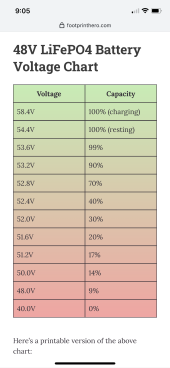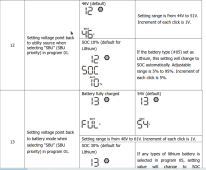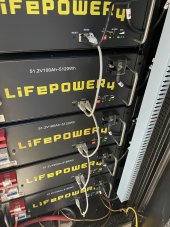JCSchwarb
Solar Enthusiast
- Joined
- Nov 26, 2022
- Messages
- 499
Hello Solar Aficionados!
Appreciate sharing thoughts on bypass modes, what typically triggers them and out to exit out of them when inverters seem stuck in that mode.
I noticed this morning that my system defaulted to bypass mode sometime since last night. When I last checked at 6pm last night my 10 LifePower4 (48V) battery bank were at 53.4V. At 6:30 they were reading 52.9V (that is a huge drop of 25% according to attached chart) and nothing going on to justify such a quick demand. Fast forward to 9am today and my batteries are at 53V and over 1kW solar generation but still in bypass with very light demand. Seems that if the system triggers to bypass it doesn’t switch back when it seems reasonable to do so. From yesterday, my power meter shows 61 kW of demand. Any settings help is much appreciated. Also, my no 6 inverter is now making a clicking sound now when in bypass after my second day in use, arggg. Seems like a known EG4 6500 issue.
Appreciate sharing thoughts on bypass modes, what typically triggers them and out to exit out of them when inverters seem stuck in that mode.
I noticed this morning that my system defaulted to bypass mode sometime since last night. When I last checked at 6pm last night my 10 LifePower4 (48V) battery bank were at 53.4V. At 6:30 they were reading 52.9V (that is a huge drop of 25% according to attached chart) and nothing going on to justify such a quick demand. Fast forward to 9am today and my batteries are at 53V and over 1kW solar generation but still in bypass with very light demand. Seems that if the system triggers to bypass it doesn’t switch back when it seems reasonable to do so. From yesterday, my power meter shows 61 kW of demand. Any settings help is much appreciated. Also, my no 6 inverter is now making a clicking sound now when in bypass after my second day in use, arggg. Seems like a known EG4 6500 issue.





